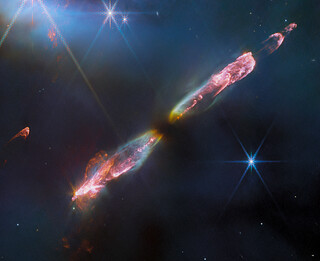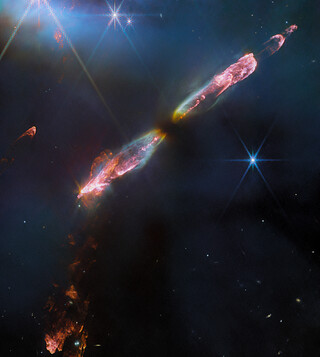weic2322 — Photo Release
Webb snaps supersonic outflow of young star
14 September 2023
This new image from the NASA/ESA/CSA James Webb Space Telescope features Herbig-Haro 211 (HH 211), a bipolar jet travelling through interstellar space at supersonic speeds. At roughly 1,000 light-years away from Earth in the constellation Perseus, the object is one of the youngest and nearest protostellar outflows, making it an ideal target for Webb.
Herbig-Haro objects are luminous regions surrounding newborn stars, and are formed when stellar winds or jets of gas spewing from these newborn stars form shockwaves colliding with nearby gas and dust at high speeds. This spectacular image of HH 211 reveals an outflow from a Class 0 protostar, an infantile analogue of our Sun when it was no more than a few tens of thousands of years old and with a mass only 8% of the present-day Sun (it will eventually grow into a star like the Sun).
Infrared imaging is powerful in studying newborn stars and their outflows, because such stars are invariably still embedded within the gas from the molecular cloud in which they formed. The infrared emission of the star’s outflows penetrates the obscuring gas and dust, making a Herbig-Haro object like HH 211 ideal for observation with Webb’s sensitive infrared instruments. Molecules excited by the turbulent conditions, including molecular hydrogen, carbon monoxide and silicon monoxide, emit infrared light that Webb can collect to map out the structure of the outflows.
The image showcases a series of bow shocks to the southeast (lower-left) and northwest (upper-right) as well as the narrow bipolar jet that powers them. Webb reveals this scene in unprecedented detail — roughly 5 to 10 times higher spatial resolution than any previous images of HH 211. The inner jet is seen to “wiggle” with mirror symmetry on either side of the central protostar. This is in agreement with observations on smaller scales and suggests that the protostar may in fact be an unresolved binary star.
Earlier observations of HH 211 with ground-based telescopes revealed giant bow shocks moving away from us (northwest) and moving towards us (southeast) and cavity-like structures in shocked hydrogen and carbon monoxide respectively, as well as a knotty and wiggling bipolar jet in silicon monoxide. Researchers have used these new observations to determine that the object’s outflow is relatively slow in comparison to more evolved protostars with similar types of outflows.
The team measured the velocities of the innermost outflow structures to be roughly 80 to 100 kilometres per second. However, the difference in velocity between these sections of the outflow and the leading material that they’re colliding with — the velocity of the shockwave — is much smaller. The researchers concluded that outflows from the youngest stars, like that in the center of HH 211, are mostly made up of molecules, because the comparatively low shock wave velocities are not energetic enough to break the molecules apart into simpler atoms and ions.
You can learn more about this research here.
This image was captured as part of the Webb Cycle One programme #1257.
More information
Webb is the largest, most powerful telescope ever launched into space. Under an international collaboration agreement, ESA provided the telescope’s launch service, using the Ariane 5 launch vehicle. Working with partners, ESA was responsible for the development and qualification of Ariane 5 adaptations for the Webb mission and for the procurement of the launch service by Arianespace. ESA also provided the workhorse spectrograph NIRSpec and 50% of the mid-infrared instrument MIRI, which was designed and built by a consortium of nationally funded European Institutes (The MIRI European Consortium) in partnership with JPL and the University of Arizona.
Webb is an international partnership between NASA, ESA and the Canadian Space Agency (CSA).
Image Credit: ESA/Webb, NASA, CSA, T. Ray (Dublin Institute for Advanced Studies)
Links
- ESA Webb Seeing Farther Interactive Brochure
- Release on STScI website
- Release on ESA website
- Release on NASA website
- Science paper
Contacts
Bethany Downer
ESA/Webb Chief Science Communications Officer
Email: [email protected]
Ninja Menning
ESA Newsroom and Media Relations Office
Email: [email protected]
About the Release
| Release No.: | weic2322 | |
|---|---|---|




